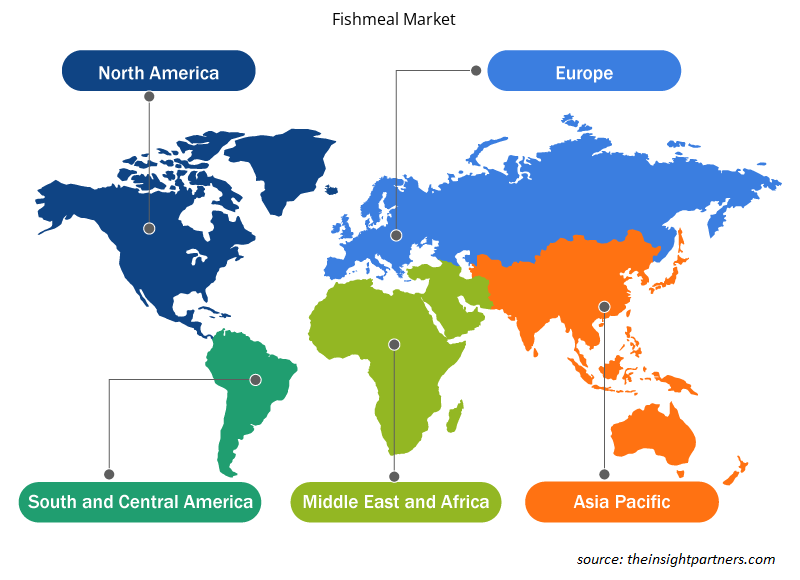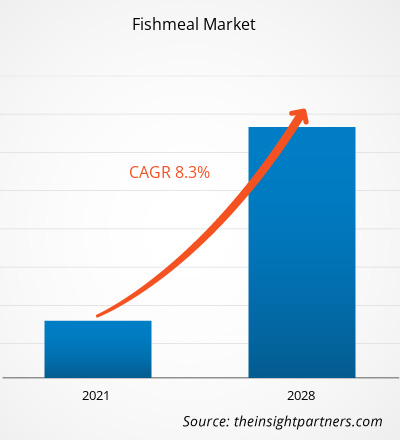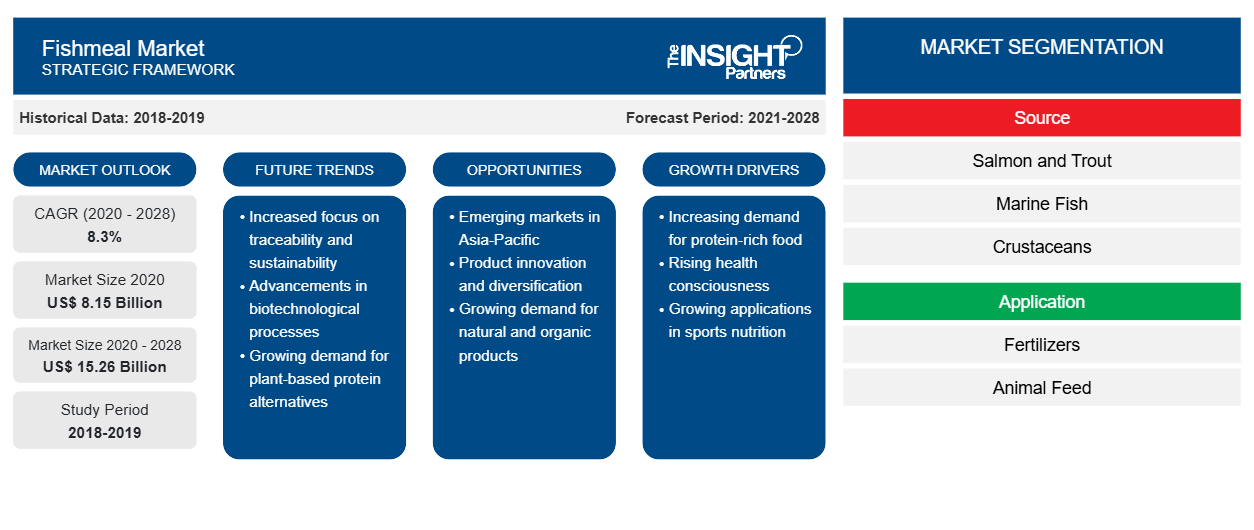Nel 2020 il mercato della farina di pesce era valutato 8.153,6 milioni di dollari USA e si prevede che raggiungerà i 15.264,6 milioni di dollari USA entro il 2028; si prevede una crescita a un CAGR dell'8,3% dal 2021 al 2028.
La farina di pesce viene prodotta utilizzando sottoprodotti ittici provenienti dalle industrie di lavorazione e filettatura degli alimenti. Viene utilizzata principalmente come ingrediente ad alto contenuto proteico (60-72%) nei mangimi prodotti per animali da allevamento e specie di acquacoltura. La domanda di farina di pesce supera l'offerta; pertanto, l'industria dei mangimi ha notevolmente modificato la composizione della farina di pesce nei mangimi. Il mercato della farina di pesce ha assistito alla crescita nel corso del periodo storico a causa dello sviluppo dell'acquacoltura dovuto alla crescente domanda di prodotti ittici e alla crescente dipendenza dall'acquacoltura da parte dei paesi in via di sviluppo per risolvere la scarsità di cibo. Inoltre, la farina di pesce è sostenibile in natura in quanto è prodotta da componenti di scarto di altre industrie. Pertanto, fa parte di vari programmi di conservazione ambientale. Il mercato trae quindi vantaggio da pratiche sostenibili, come l'agricoltura biologica.
Nel 2020, l'Asia-Pacifico ha detenuto la quota di fatturato più grande del mercato globale della farina di pesce . Inoltre, si prevede che la regione registrerà il CAGR più elevato durante il periodo di previsione. L'Asia-Pacifico comprende diverse economie importanti come India, Cina, Giappone, Corea del Sud e Australia. Questi paesi stanno assistendo a un'impennata dell'industrializzazione nel settore alimentare e delle attività di urbanizzazione, offrendo ampie opportunità per i principali attori del mercato della farina di pesce. Si prevede che l'Asia-Pacifico assisterà a una crescente domanda di farina di pesce nei prossimi anni a causa della presenza di numerosi attori nazionali di piccole e medie dimensioni nel mercato. Durante il periodo di previsione, si prevede che il mercato della farina di pesce assisterà a un'enorme domanda da parte dei settori dell'acquacoltura e dell'agricoltura biologica a causa del suo profilo altamente nutriente contenente aminoacidi essenziali. Inoltre, la farina di pesce trova applicazioni nei settori nutraceutico, farmaceutico e di altro tipo. Si prevede che il mercato della farina di pesce nell'Asia-Pacifico crescerà durante il periodo di previsione a causa dell'enorme crescita nel settore dell'acquacoltura, in particolare in India e Cina. Inoltre, l'aumento della popolazione e il crescente sostegno governativo stanno stimolando la crescita del mercato nella regione.
Personalizza questo report in base alle tue esigenze
Riceverai la personalizzazione gratuita di qualsiasi report, comprese parti di questo report, o analisi a livello nazionale, pacchetto dati Excel, oltre a usufruire di grandi offerte e sconti per start-up e università
- Scopri le principali tendenze di mercato in questo rapporto.Questo campione GRATUITO includerà analisi di dati che spaziano dalle tendenze di mercato alle stime e alle previsioni.
La pandemia di COVID-19 ha avuto un impatto negativo sul settore della pesca con interruzioni nella sua catena di fornitura. Il calo della domanda di frutti di mare ha portato a una diminuzione della produzione di pesce. La bassa domanda di pesce ha ridotto le attività della flotta ittica, il che ha avuto un impatto negativo sulla produzione di sottoprodotti ittici, in particolare farina di pesce. Tuttavia, con l'avvio di campagne di vaccinazione a livello globale, le economie si stanno riprendendo e le industrie stanno assistendo a una domanda per i loro prodotti. Vari governi stanno anche prendendo iniziative per ridurre al minimo la perdita del settore della pesca a causa di questa pandemia. Con questo, si prevede che il mercato della farina di pesce assisterà a una crescita nei prossimi anni.fishmeal. However, with the launch of vaccination drives globally, the economies are reviving, and industries are witnessing demand for their products. Various governments are also taking initiatives to minimize the loss of the fisheries industry due to this pandemic. With this, the fishmeal market is expected to witness growth in the coming years.
Approfondimenti di mercato
Domanda crescente di mangimi animali ricchi di proteine
L'industrializzazione dell'allevamento ha aumentato la domanda di ingredienti per mangimi animali ricchi di proteine per aumentare il tasso di conversione dei mangimi. Il bestiame allevato industrialmente viene nutrito principalmente con concentrati a base di proteine vegetali e cerealicole come farine di soia per aiutarli ad aumentare di peso e produrre carne ricca di proteine. Gli animali da fattoria dipendono dalle proteine e da altri elementi come elementi costitutivi essenziali per la crescita. Le proteine nei mangimi animali sono un'eccellente fonte di energia e aminoacidi essenziali, come lisina e metionina. La crescente consapevolezza dei benefici delle proteine sulla salute degli animali ha creato una domanda sostanziale di vari mangimi proteici, come farine proteiche animali, farine di piume, farine di pesce, farine di ossa e farine di sangue. La farina di pesce è una ricca fonte di proteine, minerali e acidi grassi ed è facilmente digeribile dal bestiame al momento del consumo. La farina di pesce di alta qualità consente la formulazione di diete per bestiame ricche di nutrienti, promuovendone una crescita ottimale. Poiché il bestiame e gli animali da fattoria contribuiscono in modo significativo alla filiera alimentare globale, la domanda di mangimi animali nutrienti e ricchi di proteine è in aumento e si prevede che continuerà durante il periodo di previsione. La domanda in continua crescita di mangimi per animali ricchi di proteine, volti a favorire la crescita del bestiame in tutte le fasi della vita, sta determinando un notevole incremento del mercato complessivo della farina di pesce.lysine and methionine. The growing awareness about the health benefits of proteins on animal health has created a substantial demand for various protein feeds, such as animal protein meals, feather meals, fishmeal, bone meal, and blood meal. Fishmeal is a rich source of protein, minerals, and fatty acids and is easily digested by the livestock upon consumption. High-quality fishmeal enables the formulation of nutrient-dense livestock diets, promoting their optimal growth. As livestock and farm animals contribute significantly to the global food supply chain, the demand for protein-rich nutritious animal feed is rising and is expected to continue during the forecast period. The constantly burgeoning demand for protein-rich animal feeds to promote growth in livestock at all stages of life is driving the overall fishmeal market substantially.
Informazioni sulla fonte
In base alla fonte, il mercato globale della farina di pesce è suddiviso in salmone, sgombro, acciuga, capelin e altri. Nel 2020, il segmento delle acciughe ha rappresentato la quota di fatturato maggiore. Le acciughe si trovano principalmente in SAM, soprattutto in Perù. Il volume di produzione di farina di pesce ricavata dalle acciughe peruviane equivale al fabbisogno di metà della produzione mondiale di pesce d'allevamento. Si prevede che il mercato del segmento delle acciughe registrerà una crescita durante il periodo di previsione grazie alla disponibilità di acciughe in ampia quantità. L'elevata disponibilità di acciughe ha anche un impatto positivo sulla sicurezza alimentare globale.fishmeal market is segmented into salmon, mackerel, anchovy, capelin, and others. In 2020, the anchovy segment accounted for the largest revenue share. Anchovies are majorly found in SAM, especially in Peru. The volume of fishmeal production manufactured from Peruvian anchovies is equivalent to the requirement of half of the global fed farmed fish production. The market for the anchovy segment is expected to witness growth during the forecast period due to the availability of anchovies in ample quantity. The high availability of anchovies also has a positive impact on the global food security.
Approfondimenti sulle applicazioni
In base all'applicazione, il mercato globale della farina di pesce è segmentato in mangimi per animali, agricoltura e altri. Nel 2020, il segmento dei mangimi per animali ha rappresentato la quota di fatturato maggiore. La farina di pesce è un ingrediente per mangimi altamente digeribile, che apporta un'elevata quantità di energia per unità di peso. Contiene pochi carboidrati ed è un'eccellente fonte di vitamine, minerali, oli (lipidi) e proteine. Molte farine di pesce commerciali sono realizzate con pesci piccoli e ossei, che non sono adatti al consumo umano o prodotti da sottoprodotti dell'industria di lavorazione del pesce. Pertanto, la valorizzazione dei sottoprodotti rende economica la farina di pesce per mangimi per animali. Quindi, il miglioramento dei mangimi per animali con l'aiuto della farina di pesce sta guidando la crescita del mercato per questo segmento.fishmeal market is segmented into animal feed, agriculture, and others. In 2020, the animal feed segment accounted for the largest revenue share. Fishmeal is a highly digestible feed ingredient, carrying a high amount of energy per unit weight. It contains little carbohydrate and is an excellent source of vitamins, minerals, oils (lipids), and proteins. Many commercial fishmeal are made from small and bony fishes, which are not suitable for consumption by human or manufactured from by-products of the fish processing industry. Therefore, the valorization of by-products makes the fishmeal animal feed economical. Hence, the enhancement of animal feed with the help of fishmeal is driving the market growth for this segment.
TripleNine, The Scoular Company, FF SKAGEN A/S, Pelagia AS, Soytex LTD, Pesquera Diamante SA, TASA, Oceana Group Limited, Omega Protein Corporation e COPEINCA sono alcuni dei player affermati nel mercato globale della farina di pesce. Le aziende del mercato stanno adottando strategie come lo sviluppo di prodotti, l'espansione degli impianti e le fusioni e acquisizioni per espandere la propria presenza in tutto il mondo e soddisfare la crescente domanda degli utenti finali. Ad esempio, a settembre 2021, Scoular ha lanciato un nuovo marchio Encompass per la sua crescente attività di farina di pesce., The Scoular Company, FF SKAGEN A/S, Pelagia AS, Soytex LTD, Pesquera Diamante S.A., TASA, Oceana Group Limited, Omega Protein Corporation, and COPEINCA are a few well-established players in the global fishmeal market. Companies in the market are adopting strategies such as product developments, plant expansions, and mergers and acquisitions to expand their footprint worldwide and meet the growing demand from end users. For instance, in September 2021, Scoular launched a new brand Encompass for its growing fishmeal business.
Approfondimenti regionali sul mercato della farina di pesce Market Regional Insights
Le tendenze regionali e i fattori che influenzano il mercato della farina di pesce durante il periodo di previsione sono stati ampiamente spiegati dagli analisti di Insight Partners. Questa sezione discute anche i segmenti e la geografia del mercato della farina di pesce in Nord America, Europa, Asia Pacifico, Medio Oriente e Africa e Sud e Centro America.Fishmeal Market throughout the forecast period have been thoroughly explained by the analysts at Insight Partners. This section also discusses Fishmeal Market segments and geography across North America, Europe, Asia Pacific, Middle East and Africa, and South and Central America.

- Ottieni i dati specifici regionali per il mercato della farina di pesce
Ambito del rapporto sul mercato della farina di pesce
| Attributo del report | Dettagli |
|---|---|
| Dimensioni del mercato nel 2020 | 8,15 miliardi di dollari USA |
| Dimensioni del mercato entro il 2028 | 15,26 miliardi di dollari USA |
| CAGR globale (2020 - 2028) | 8,3% |
| Dati storici | 2018-2019 |
| Periodo di previsione | 2021-2028 |
| Segmenti coperti | Per fonte
|
| Regioni e Paesi coperti | America del Nord
|
| Leader di mercato e profili aziendali chiave |
|
Densità degli operatori del mercato della farina di pesce: comprendere il suo impatto sulle dinamiche aziendali
Il mercato del Fishmeal Market sta crescendo rapidamente, spinto dalla crescente domanda degli utenti finali dovuta a fattori quali l'evoluzione delle preferenze dei consumatori, i progressi tecnologici e una maggiore consapevolezza dei benefici del prodotto. Con l'aumento della domanda, le aziende stanno ampliando le loro offerte, innovando per soddisfare le esigenze dei consumatori e capitalizzando sulle tendenze emergenti, il che alimenta ulteriormente la crescita del mercato.
La densità degli operatori di mercato si riferisce alla distribuzione di aziende o società che operano in un particolare mercato o settore. Indica quanti concorrenti (operatori di mercato) sono presenti in un dato spazio di mercato in relazione alle sue dimensioni o al valore di mercato totale.
Le principali aziende che operano nel mercato della farina di pesce sono:
- Triplo Nove
- La compagnia Scoular
- FF SKAGEN A/S
- Pelagia AS
- Soytex LTD
Disclaimer : le aziende elencate sopra non sono classificate secondo un ordine particolare.

- Ottieni una panoramica dei principali attori del mercato della farina di pesce
Segnala i riflettori
- Tendenze progressive del settore nel mercato globale della farina di pesce per aiutare gli operatori a sviluppare strategie efficaci a lungo termine
- Strategie di crescita aziendale adottate dai mercati sviluppati e in via di sviluppo
- Analisi quantitativa del mercato globale della farina di pesce dal 2019 al 2028
- Stima della domanda di farina di pesce nei vari settori
- Sviluppi recenti per comprendere lo scenario competitivo del mercato e la domanda di farina di pesce
- Tendenze e prospettive del mercato, insieme ai fattori che guidano e frenano la crescita del mercato della farina di pesce
- Processo decisionale attraverso la comprensione delle strategie che sostengono l'interesse commerciale in relazione alla crescita del mercato globale della farina di pesce
- Dimensioni del mercato della farina di pesce nei vari nodi del mercato
- Panoramica dettagliata e segmentazione del mercato globale della farina di pesce nonché delle sue dinamiche nel settore
- Dimensioni del mercato della farina di pesce in varie regioni con promettenti opportunità di crescita
Mercato della farina di pesce, per fonte
- Salmone
- Sgombro
- Acciuga
- Capelin
- Altri
Mercato della farina di pesce, per applicazione
Profili aziendali
- Triplo Nove
- La compagnia Scoular
- FF SKAGEN A/S
- Pelagia AS
- Soytex LTD
- Pesca Diamante SA
- TASA
- Gruppo Oceana Limited
- Società proteica Omega
- COPPAINCA
- Analisi storica (2 anni), anno base, previsione (7 anni) con CAGR
- Analisi PEST e SWOT
- Valore/volume delle dimensioni del mercato - Globale, Regionale, Nazionale
- Industria e panorama competitivo
- Set di dati Excel
Report recenti
Testimonianze
Motivo dell'acquisto
- Processo decisionale informato
- Comprensione delle dinamiche di mercato
- Analisi competitiva
- Analisi dei clienti
- Previsioni di mercato
- Mitigazione del rischio
- Pianificazione strategica
- Giustificazione degli investimenti
- Identificazione dei mercati emergenti
- Miglioramento delle strategie di marketing
- Aumento dell'efficienza operativa
- Allineamento alle tendenze normative























 Ottieni un campione gratuito per - Mercato della farina di pesce
Ottieni un campione gratuito per - Mercato della farina di pesce